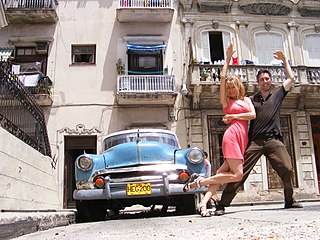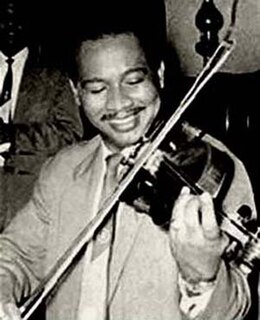
Salsa music is a style of Latin American music. Because most of the basic musical components predate the labeling of salsa, there have been many controversies regarding its origin. Most songs considered as salsa are primarily based on son montuno, with elements of mambo, Latin jazz, bomba, plena and guaracha. All of these elements are adapted to fit the basic son montuno template when performed within the context of salsa.
The term conjunto refers to several types of small musical ensembles present in different Latin American musical traditions, mainly in Mexico and Cuba. While Mexican conjuntos play styles such as norteño and tejano, Cuban conjuntos specialize in the son, as well as its derivations such as salsa.
Charanga is a traditional ensemble that plays Cuban dance music. They made Cuban dance music popular in the 1940s and their music consisted of heavily son-influenced material, performed on European instruments such as violin and flute by a Charanga orchestra.. The style of music that is most associated with a Charanga is termed 'Danzón', and is an amalgam of both European classical music and African rhythms.
Danzón is the official musical genre and dance of Cuba. It is also an active musical form in Mexico, and is much loved in Puerto Rico as well. Written in 2
4 time, the danzón is a slow, formal partner dance, requiring set footwork around syncopated beats, and incorporating elegant pauses while the couples stand listening to virtuoso instrumental passages, as characteristically played by a charanga or típica ensemble.

Orquesta típica, or simply a típica, is a Latin American term for a band which plays popular music. The details vary from country to country. The term tends to be used for groups of medium size in some well-defined instrumental set-up.

Timba is a Cuban genre of music based on Cuban son with salsa, American funk/R&B and the strong influence of Afro-Cuban folkloric music. Timba rhythm sections differ from their salsa counterparts, because timba emphasizes the bass drum, which is not used in salsa bands. Timba and salsa use the same tempo range and they both use the standard conga marcha. Almost all timba bands have a trap drummer. Timbas also often break the basic tenets of arranging the music in-clave. Timba is considered to be a highly aggressive type of music, with rhythm and "swing" taking precedence over melody and lyricism. Associated with timba is a radically sexual and provocative dance style known as despelote. It is a dynamic evolution of salsa, full of improvisation and Afro Cuban heritage, based on son, Rumba and mambo, taking inspiration from Latin jazz, and is highly percussive with complex sections. Timba is more flexible and innovative than salsa, and includes a more diverse range of styles. Timba incorporates heavy percussion and rhythms which originally came from the barrios of Cuba.

Ray Barretto was an American percussionist and bandleader of Puerto Rican ancestry. Throughout his career as a percussionist, he played a wide variety of Latin music styles, as well as Latin jazz. His first hit, "El Watusi", was recorded by his Charanga Moderna in 1962, becoming the most successful pachanga song in the United States. In the late 1960s, Barretto became one of the leading exponents of boogaloo and what would later be known as salsa. Nonetheless, many of Barretto's recordings would remain rooted in more traditional genres such as son cubano. A master of the descarga, Barretto was a long-time member of the Fania All-Stars. His success continued into the 1970s with songs such as "Cocinando" and "Indestructible." His last album for Fania Records, Soy dichoso, was released in 1990. He then formed the New World Spirit jazz ensemble and continued to tour and record until his death in 2006.
Orquesta Aragón is a Cuban musical band formed on 30 September 1939, by Orestes Aragón Cantero in Cienfuegos, Cuba. The band originally had the name Ritmica 39, then Ritmica Aragón before settling on its final form. Though they did not create the Cha-cha-cha, they were arguably the best charanga in Cuba during the 1950s and 1960s. Their trade-marks included high-class instrumentalists playing in tight ensemble style, and rhythmical innovations which kept their sound up to date. Over the years they progressed from their start as a danzoneria to play a wider variety of styles, danzón, then cha-cha-cha, then onda-cha, pachanga and son fusions. They still perform today, based in Havana.
Pachanga is a genre of music which is described as a mixture of son montuno and merengue and has an accompanying signature style of dance. This type of music has a festive, lively style and is marked by jocular, mischievous lyrics. Pachanga originated in Cuba in the 1950s and played an important role in the evolution of Caribbean style music as it is today. Considered a prominent contributor to the eventual rise of salsa, Pachanga itself is an offshoot of Charanga style music. Very similar in sound to Cha-Cha but with a notably stronger down-beat, Pachanga once experienced massive popularity all across the Caribbean and was brought to the United States by Cuban immigrants post World War II. This led to an explosion of Pachanga music in Cuban music clubs that influenced Latin culture in the United States for decades to come.

Juan Pablo Pacheco Knipping, known as Johnny Pacheco, was a Dominican musician, arranger, composer, bandleader, and record producer who in the 1970s became one of the leading exponents of salsa as well in the late 1950s called the pachanga, a blend of Cuban rhythms and Dominican merengue, which propelled him to worldwide fame and had an important role in the evolution of Latin music.
Songo-salsa is a style of music that blends Spanish rapping and hip hop beats with salsa music and songo. Well-known exponents include Bamboleo and Charanga Habanera.
Duranguense is a genre of Regional Mexican music. It is a hybrid of Technobanda and Tamborazo. Its popularity peaked in the mid to late 2000s among the Mexican and Mexican American community in the United States, as well as in many parts of Mexico. The instruments held over from tamborazo are the saxophone, trombone, and tambora, while the instruments held over from technobanda are the electronic keyboard, drum set, and vocals. The electronic keyboard is emphasized in Duranguense, giving the genre its own signature riff. The genre popularized the dance style, Pasito Duranguense.
Richard Egües, nicknamed "la flauta mágica", was a Cuban flautist and musician, one of the country's most famous artists. Egües was a member of the Orquesta Aragón band which he joined in 1955. He was also a strong supporter of the Cuban Revolution. A few days before he died, Richard Egües stated "I would give my life for him", referring to the Cuban President Fidel Castro, who was very sick at the time.

Enrique Jorrín was a Cuban charanga violinist, composer and music director. He is considered the inventor of the cha-cha-chá, a popular style of ballroom music derived from danzón.
Cha-cha-chá is a genre of Cuban music. It has been a popular dance music which developed from the Danzón-mambo in the early 1950s, and became widely popular throughout the entire world.
La Charanga Habanera is a timba ensemble from Havana directed by David Calzado. The band has been nominated for awards including the Latin Grammy in 2003 for the album Live in the U.S.A. In 2005 Charanga Habanera was nominated for "Orgullosamente Latino" awards in three categories: best video, best album, and best group. Furthermore, the group has won numerous awards from Cubadiscos and Lucas.
Orquesta Broadway was an American mid-1960s/late 1980s New York-based salsa band. They issued almost 20 albums between 1964 and 1987.

A Charanga is a small amateur marching band with wind and percussion instruments that plays festivals mainly in Northern Spain, Castilla-La Mancha, Castilla y León and the Valencian Community. In the past, the name charanga also applied to certain military musical bands of the Spanish Army and as ship's company bands in the Spanish Navy.
Melquíades Fundora Dina is a Cuban charanga bandleader and flautist. He formed his charanga band La Sublime in 1957.
José Antonio Fajardo was a Cuban charanga bandleader and flautist, who played the traditional five-keyed wooden flute.






